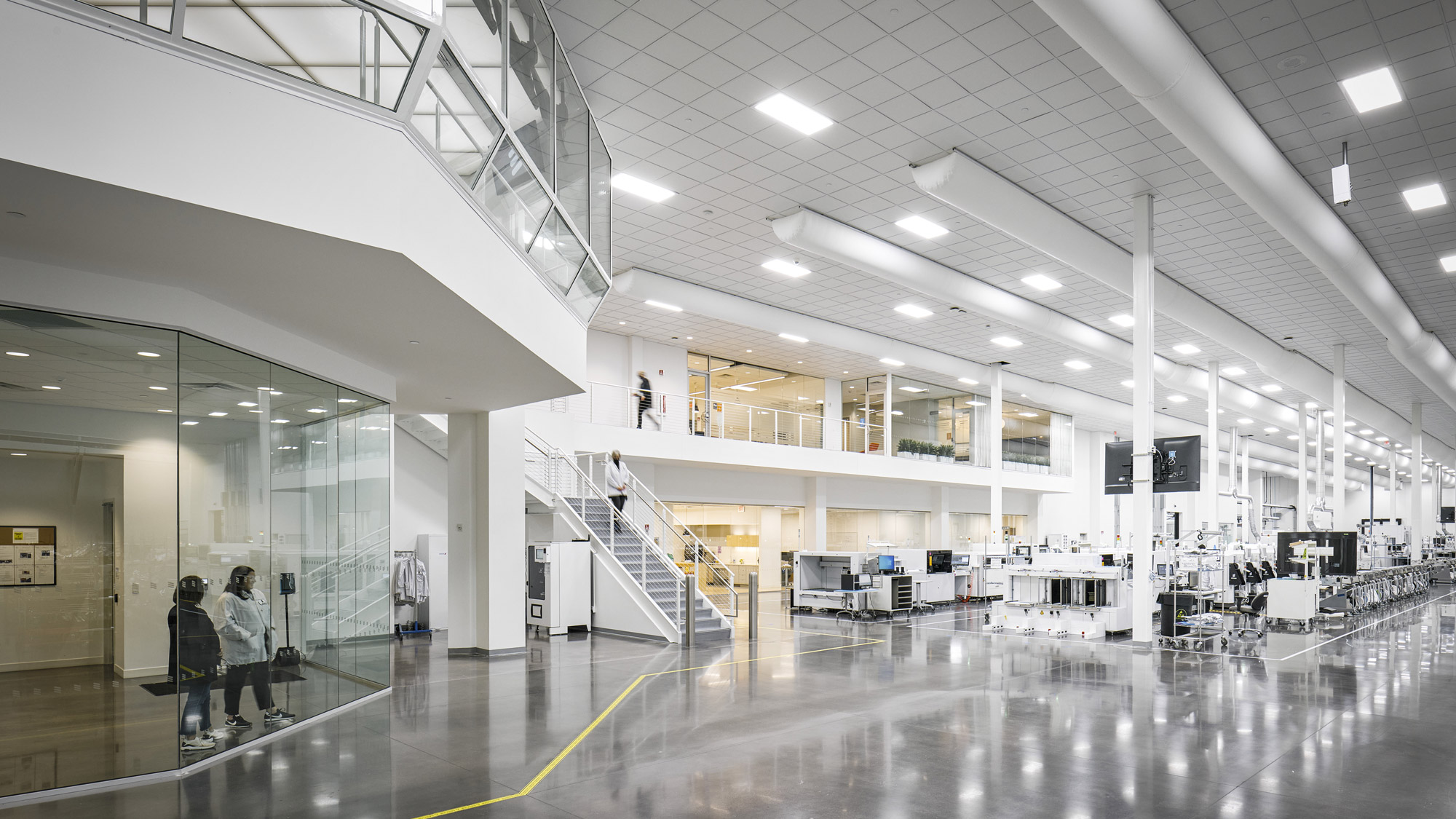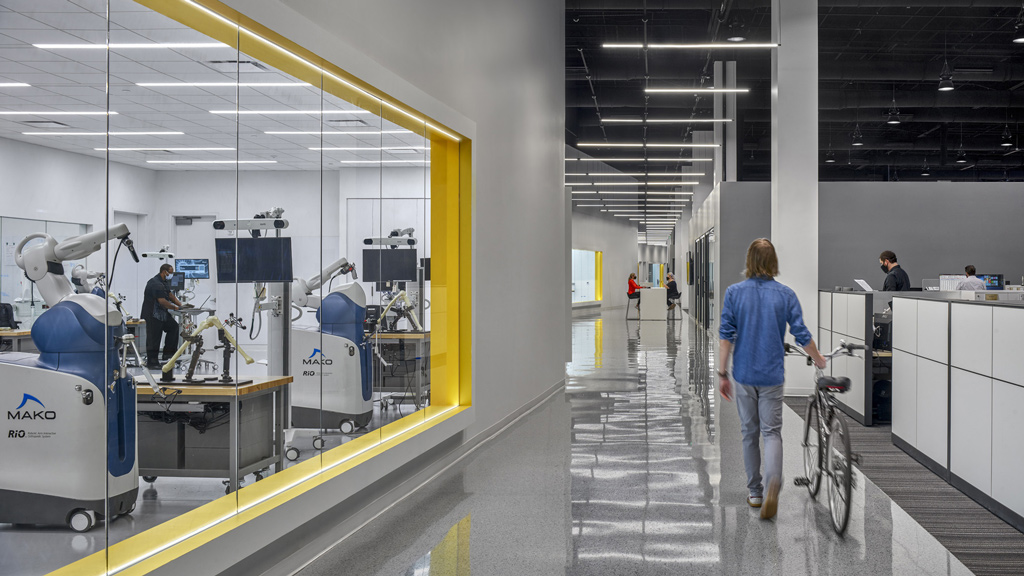Smart Design for Smart Manufacturing: Five Ways Manufacturing Has Evolved
October 08, 2024 | By Scott Vittorelli
As with virtually every industry, emerging technologies are making their mark in manufacturing. We are seeing the evolution of this sector in real time, as advances in robotics, automation, and the Internet of Things (IoT) enable more efficient, cost-saving, and resilient outcomes.
Manufacturing will only get smarter. Signaling incredible opportunity, a 2023 report projects the market is expected to grow at a compound annual growth rate of 13.1% by 2030, totaling $658.41 billion. As architects and designers, we can tap into this growth to reimagine struggling assets in our built environment.
While there are undoubtedly more to come, here are five key trends in manufacturing’s progression to date that offer a springboard to improving our processes and designing for lasting impact.
1. Adopting Advanced Technologies
Technological innovation is the impetus of the industry’s shift. Compared to traditional processes, new technological capabilities enhance the worker experience, the functionality of facilities, and business performance.
Robots are advantageous in many ways, namely for productivity and improved safety. They can perform repetitive tasks with precision, limiting the likelihood of human error, and are also capable of handling hazardous tasks, protecting workers and preventing injuries. Compared with traditional processes, automation also allows companies to reduce labor costs and increase production speed, often leading to substantial savings. And for greater efficiency and streamlined operations, IoT integration is key to ensuring all parts of the manufacturing process are interconnected.
Driven by advanced digital technologies such as these, the era of smart factories is taking hold, defined by connected systems and data analytics that drive decision-making and improve workflows.
2. Improving Sustainability and Green Manufacturing
Manufacturing facilities are generally not thought of as environmentally friendly, but the new iteration of these properties is changing that narrative.
Modern facilities are incorporating energy efficient technologies and renewable energy sources to reduce their carbon footprint. Advanced manufacturing techniques such as 3D printing and lean manufacturing are being used to help minimize waste, and smart water usage systems are being implemented as another means for waste management by optimizing usage and prioritizing conservation.
As the industry adapts to and anticipates ongoing climate change, there is a growing emphasis on meeting environmental regulations and standards, paving the way for the adoption of greener practices.

3. Humanizing the Employee Experience
Today’s facilities are beginning to take a new form, drawing inspiration from workplace and office amenities to support employee wellbeing and boost productivity.
Countering what might come to mind when envisioning a factory, modern spaces are designed to maximize natural light and on-site cafeterias with healthy options are becoming standard.
Like tech companies, manufacturing facilities are starting to feature more modern amenities, such as comfortable break areas, on-site gyms, and wellness programs to improve employee satisfaction. An increased focus on collaborative spaces for teamwork and innovation is taking hold and some facilities are even adopting flexible work options, including remote work for certain roles, to attract and retain top talent.
4. Recruiting New Talent
More than ever, manufacturing companies are now seeking tech-savvy individuals who can operate and manage the advanced machinery and digital systems commonly found in these facilities. They are also investing in current employees, offering training and development programs to educate their workforces on the latest technologies and master all required skills.
By offering competitive salaries, benefits, career advancement opportunities, and contemporary workplaces, manufacturing companies are prioritizing the employee experience and draw the best candidates in a competitive job market.
5. Embracing a Startup Mindset
Countering the typical factory look and feel, many manufacturing offices are adopting tech-inspired influences to bring new energy to their spaces.
Open floor plans, as can be found in many tech workplaces, are becoming more common to foster collaboration and improve communication. To encourage fresh thinking, drive technological advancements, and develop new products, companies are establishing innovation hubs and R&D centers within their facilities. And a startup culture is being cultivated to reinforce values of agility, ingenuity, and a willingness to embrace new ideas.

The Role We Play as Architects and Interior Designers
Taking these trends into account, our industry can keep pace with the changing nature of manufacturing by creating spaces that effectively meet the industry’s needs today and anticipate its needs tomorrow.
To summarize, some of the top considerations for modern facility design include:
- Optimized Layouts: Architects can design floor plans that enhance workflow, efficiency, and safety within manufacturing facilities.
- Ergonomic Design: Interior designers can create flexible workstations and environments that improve employee comfort and productivity.
- Aesthetic Appeal: Designing visually compelling spaces can boost morale and create a more enjoyable working environment.
- Sustainable Design: Incorporating sustainable materials and energy-efficient solutions to reduce environmental impact and operational costs is key.
- Natural Light: Maximizing daylight is crucial to both enhancing employee wellbeing and reducing reliance on artificial lighting.
- Collaborative Spaces: To build comradery and support teamwork, agile spaces for collaboration are a necessity.
- Comfort and Amenities: Incorporating modern amenities like on-site gyms, cafeterias, and break areas go a long way to attract and retain top talent.
- Smart Technology Integration: Spaces that seamlessly integrate with smart technologies and IoT devices yield improved operational efficiency.
- Future-Proofing: Adaptable places that can evolve alongside technological advancements will support changing business needs.
- Building Systems: To support advanced machinery and ensure reliable operations, upgrading infrastructure to meet power and water requirements is crucial.
The confluence of advanced technologies, sustainable practices, and evolving workplace trends suggests new life and new uses are possible for a largely ubiquitous building typology. Armed with these insights, we can immediately rethink facilities of old and prepare for even greater change ahead.
For media inquiries, email .

